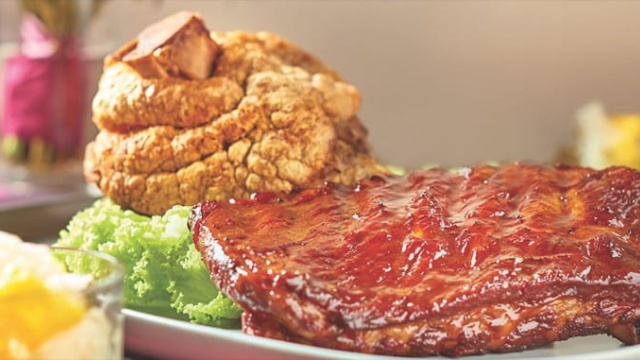While celebrations of Lunar New Year — the biggest festival in many Asian cultures following the lunar calendar — vary from place to place, the common theme is family reunion, which oftentimes revolves around festive foods that are specific to this time of the year. From glutinous dumplings in Hong Kong to lo hei in Singapore, there’s so much to explore when it comes to Lunar New Year food traditions in the region.
So in the spirit of the festivities, we ask MICHELIN restaurants in Hong Kong, Singapore, Taiwan, Thailand and Seoul to introduce the most beloved dishes from their destinations, as well as the symbolic meanings behind them.
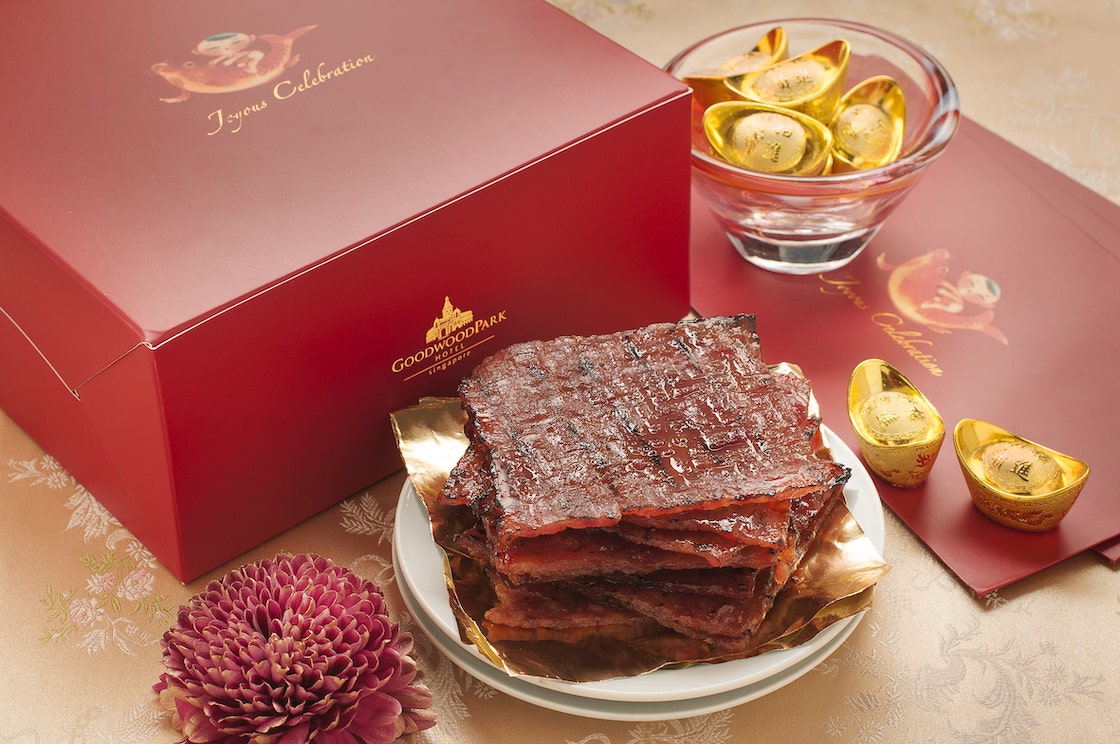
Singapore
Bak Kwa (Barbecued Pork Jerky)
In Singapore, bak kwa, which literally translates to “dried meat”, is synonymous with Chinese New Year. These succulent barbecued meats are often dipped in a sugar and spice marinade before being air dried and roasted over charcoal. The square sheets of bak kwa are popular during the festive season because of their red hue, which the Chinese believe signifies luck and fortune.
“I am a big fan of bak kwa,” says chef Chan Hwan Kee of MICHELIN-listed Chinese restaurant Min Jiang at Dempsey in Singapore. “When I was younger, bak kwa was considered a delicacy as we only got to eat it during Chinese New Year,” he says. This Hokkien treat is said to originate from the province of Fujian in China, where the consumption of meat was considered a luxury in the past and only kept for special occasions.
“I grew up eating bak kwa made with very lean sliced meat, so it had a chewy texture. Now, I much prefer having minced meat bak kwa as it is more tender,” the chef shares. At Min Jiang at Dempsey, Chan grills the sheets of marinated meat over charcoal to lend it a smoky fragrance. “Taste-wise, I like bak kwa that is slightly sweet and savoury with a little char. I’m glad that our guests and I get to enjoy this year after year.”
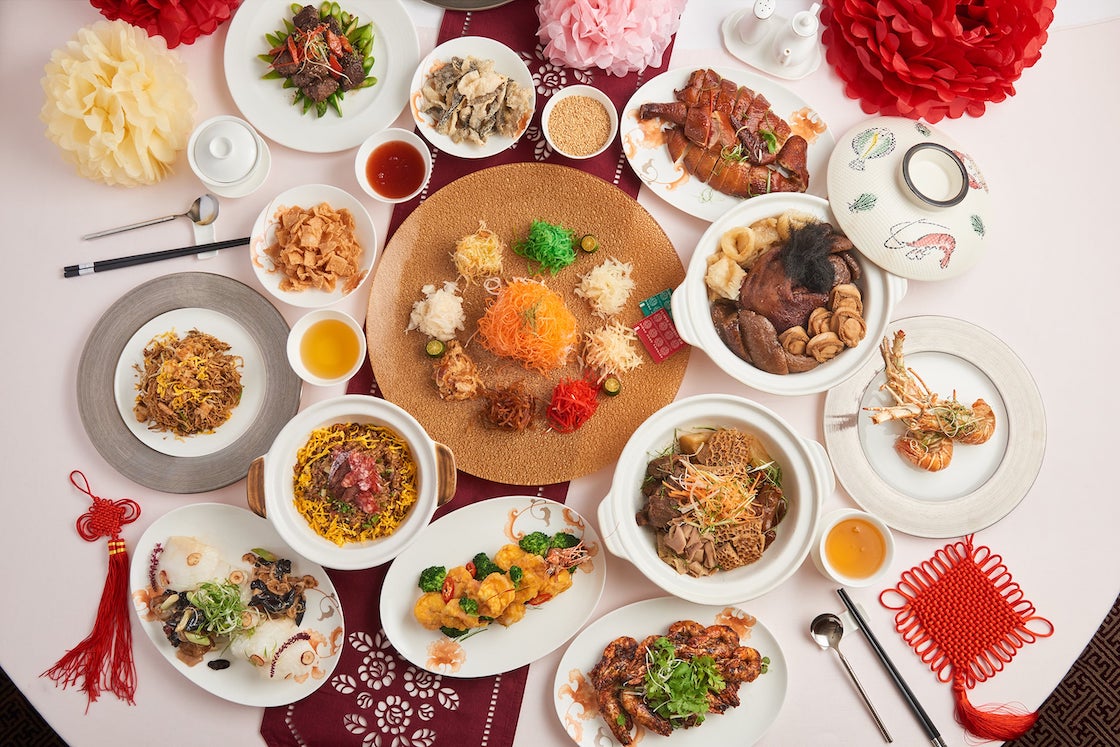
Yu Sheng (Raw Fish Salad)
Yu sheng is a dish of shredded vegetables and raw fish, eaten widely in Singapore during Chinese New Year because the words yu sheng (raw fish) are also a homonym for “abundance rising”.
Traditionally, the vibrantly hued dish comprises slivers of raw fish (saito and salmon) and julienned pickled vegetables such as carrots, white radish, green radish, cucumbers, ginger, and onion slices, as well as pomelo. The melange is drenched in oil and plum sauce, followed by a shower of chopped peanuts and pok chui crackers.
The various components of the salad are added in a specific sequence, and each ingredient carries an auspicious meaning that is linked to a Chinese couplet. Diners then toss the communally enjoyed salad together with chopsticks, while spouting auspicious sayings in a practice called lo hei. In Singapore, there are many combinations of yu sheng available in the island's many Chinese restaurants, including vegetarian options and luxe versions that contain abalone and caviar.
At one-MICHELIN-starred Summer Palace, yu sheng is a dish that almost every table will order during the Chinese New Year season, says executive chef Liu Ching Hai. “From close relatives and loved ones, to acquaintances you might only see once a year, lo hei has a way of breaking the ice and creating that festive atmosphere,” he adds.
Liu also shares that he found the practice strange when he first moved to Singapore from Hong Kong more than 30 years ago, but has since come to embrace the festive dish. “We have already started seeing other countries like Malaysia and Hong Kong picking up this practice of lo hei. I believe it’s a Singaporean dish that can go far because with some creativity, all the components can be adapted to different food cultures, and it is something that is so celebratory and meaningful,” he adds.
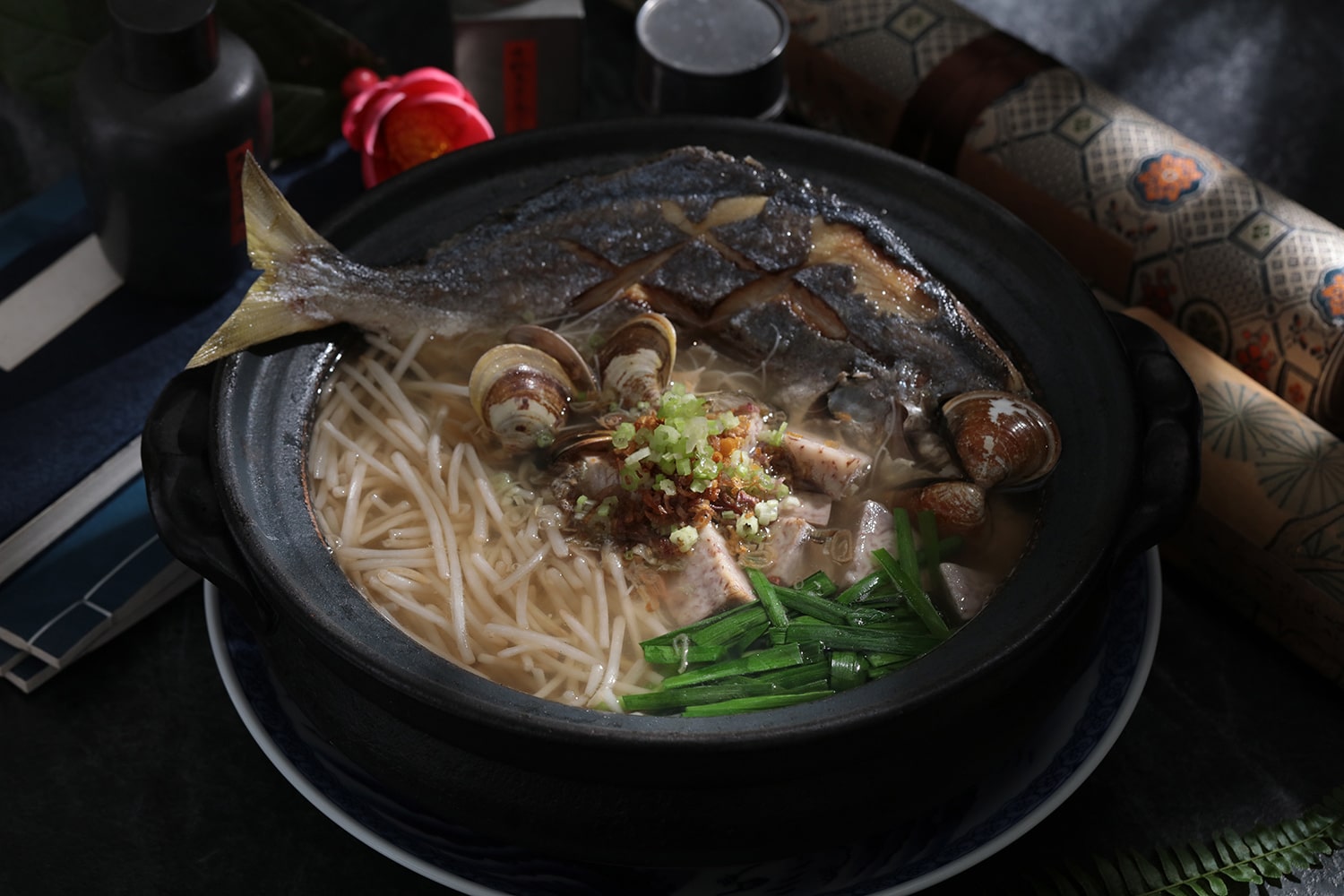
Taiwan
Hot pot
Chinese New Year is a time for family reunion—sitting around a steaming hot pot, putting in all kinds of different ingredients, taking whatever you want to enjoy while sharing lives and chatting with each other - hot pot has been one of most common dishes served at Taiwan’s New Year’s Eve dinner.
“There’s no fixed way to prepare the hot pot. The dish emphasizes the concept of ‘getting together’," said Leo Tsai, executive chef of one-Michelin-starred Mountain and Sea House. In fact, each family often has its own preferences and traditions when it comes to the preparation of the hot pot broth or ingredients. For chef Tsai, whose hometown is in Taixi, Yunlin County, a township that is close to the sea, his Chinese New Year hot pot will be filled with fresh seafood such as oysters and clams. Meanwhile, at Mountain and Sea House, chef has created a “White Pomfret Noodle Soup” dish for Lunar New Year as the term for white pomfret sounds like “prosperity” in Chinese. Diners can also add their preferred ingredients such as fish fillets or vegetables into the soup, just like when they are enjoying hot pot.
READ MORE: What Is Taiwanese Gua Bao?

Whole chicken
Another iconic dish on Taiwanese dinner tables on Chinese New Year Eve is “whole chicken”—the pronunciation of “chicken” is close to “auspicious” in Chinese and “eating chicken” is homophonic to “build up fortune and thrive” in the Taiwanese dialect. The chicken is always served whole, which symbolises family reunion and life coming full circle. Chef Tsai explains that because the whole chicken dish at Chinese New Year Eve’s dinner is usually also prepared for religious offerings to deities and ancestors during the day, it is usually eaten cold, and has to be cooked in a way that could endure long hours without losing its flavour and textures.
Mountain and Sea House offers steamed free-range chicken and sugarcane-smoked free-range chicken for Chinese New Year. The steamed chicken is usually blanched and salted before being hung dry but chef Tsai cooks with a relatively lower heat to make the meat more succulent. The chicken is then served with Hakka kumquats and Taiwanese garlic soy sauce. The free-range chicken is marinated with concentrated sugarcane juice for 24 hours, hung dry and then smoked over sugarcane to give it a special fragrance.

Hong Kong
Tong yoon
Almost all festive dishes enjoyed during Lunar New Year involve auspicious wordplay and these chewy dumplings are no exception. Literally meaning “soup balls”, the name of these glutinous rice dumplings (“tong yoon”) has a similar sound to “tun yun”, which means reunion in Cantonese.
Traditionally filled with black sesame paste or chopped peanuts, tong yoon is loved for its sticky, mochi-like texture. The Cantonese way of serving tong yoon is in a hot ginger soup to counterbalance the lusciously sweet filling. You can find modern versions of tong yoon with different kinds of fillings available on the market, such as red bean paste, chocolate, smashed taro and custard.
READ MORE: Michelin Chefs Reveal Their "Golden Ratio" For Cantonese Turnip Cake

Poon choi
A uniquely Hong Kong speciality originating from the walled village communities of the New Territories, poon choi is a communal meal served during festivals, wedding banquets, and Lunar New Year. “Poon'' refers to the container which is usually a wooden basin used in a communal feast, while “choi” refers to the food, which is layered in a way that the most expensive ingredients, like abalone, chicken and sea cucumber, are placed at the top to emphasise prosperity. The middle of poon choi is usually padded out with pork and Chinese dried mushrooms, while ingredients that absorb sauces, such as Chinese radishes, pigskins and bean curd are placed at the bottom.
Poon choi symbolises unity and togetherness, a celebratory feast that gathers everyone in the village in one place. This symbolic meaning has passed down to the present day, where restaurants in the urban districts begin to create their own versions of poon choi, especially during the winter solstice and Lunar New Year.

Thailand
Kai op
In Thailand, the Chinese-Thai community celebrates Chinese New Year with family and friends to honour their ancestors. It’s the time when relatives reunite at the main family home, surrounded by delicious food that demonstrate their prosperity. With our modern, fast-paced lifestyle today, Chinese New Year offerings now take many forms, including fast food. However, one of the most popular and unmissable dishes you’ll find on the table is the whole chicken.
“Serving a whole chicken represents wholeness and prosperity,” explained Chef Wasan Jitjaroonruang of Dai Lou, a MICHELIN-recommended Chinese restaurant in Bangkok. “Chicken is also another visual signifier of unity and can be prepared in so many ways from poaching, grilling to roasting.”
The chef’s whole roasted chicken is based on this concept of prosperity and unity. “Imperial Treasure Roasted Chicken is a dish I created, consisting of symbolic ingredients stuffed inside a beautiful chicken. Prawn, sea cucumber, and crispy pickled squid symbolise joy and happiness. Chestnuts show wealth, and pork innards represent strength. Noodles are for longevity, and celery, huai shan, ginkgo, and bell peppers were added for their health benefits. We also add smoked duck breast for flavour and aroma.”
The chef also added: “The secret to this delicacy starts with selecting the finest ingredients, to bring out natural flavours at their best. We also carefully debone the chicken while keeping its form before adding the stuffing that has been beautifully stir-fried. After that, it’s roasted for an hour before we pour hot oil on the skin for a more lip-smacking appeal. Then, it’s finished off with special abalone gravy that brings everyone joy and happiness all around.”
READ MORE: 8 Inspired Benja Chicken Dishes From Chefs Of MICHELIN Star Fame
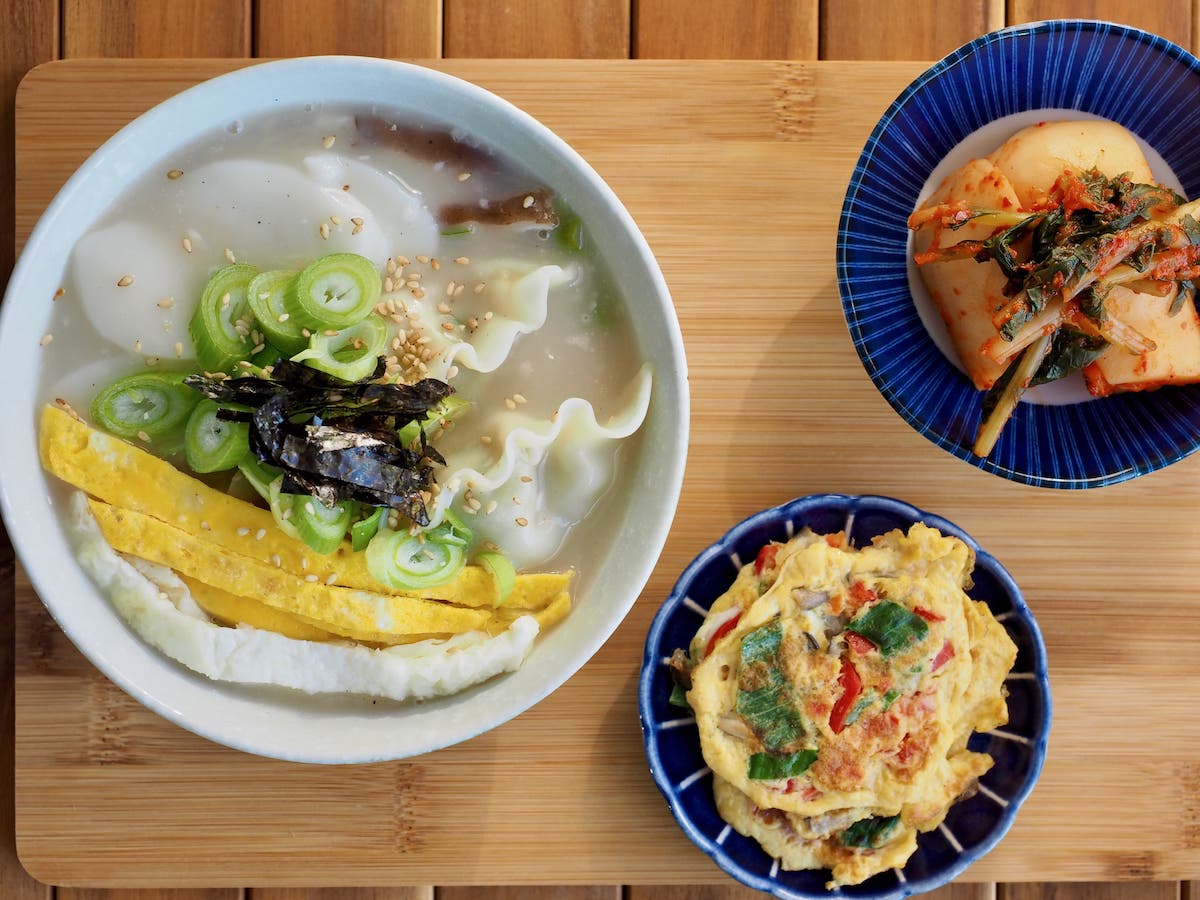
Seoul
Tteokguk
A traditional Korean dish eaten during celebrations of the Korean New Year, “tteok” means rice cake, and “guk” means soup in Korean.
Chef Kim of MICHELIN-recommended Sanok says the many ways to cook and enjoy tteokguk vary from region to region. The recipes also differ from family to family. The broth is generally made by simmering a stock made from beef bones, but in some regions dried anchovies and kelp are used instead. He says that this difference makes this food more attractive. If someone gets married and makes tteokguk, a new recipe can be created by the new family.
To make the soup, chef Kim prefers to use beef and beef bone together to make the flavour stronger. He also adds an abundance of garnishes, including soy sauce marinated and stir-fried ground-beef. Also, well-aged kimchi goes well with tteokguk because it adds a crispy texture and an attractive acidity to the flavour, according to the chef.
It is a tradition to eat tteokguk on New Year's Day because it is believed that the dish will grant diners good luck for the year as they gain another year of age and wisdom. Not everyone sees this as a welcome thing, however: so some people humorously avoid eating tteokguk to avoid getting old, and sometimes joke that one gets two years older if they eats two bowls of tteokguk at a go.
Written by Pruepat “Maprang” Songtieng in Bangkok, Julia Lee in Seoul, Rachel Tan & Mikka Wee in Singapore, Pearl Yan in Hong Kong, and Hsieh Ming-ling in Taiwan; introduction and edits by Pearl Yan.











